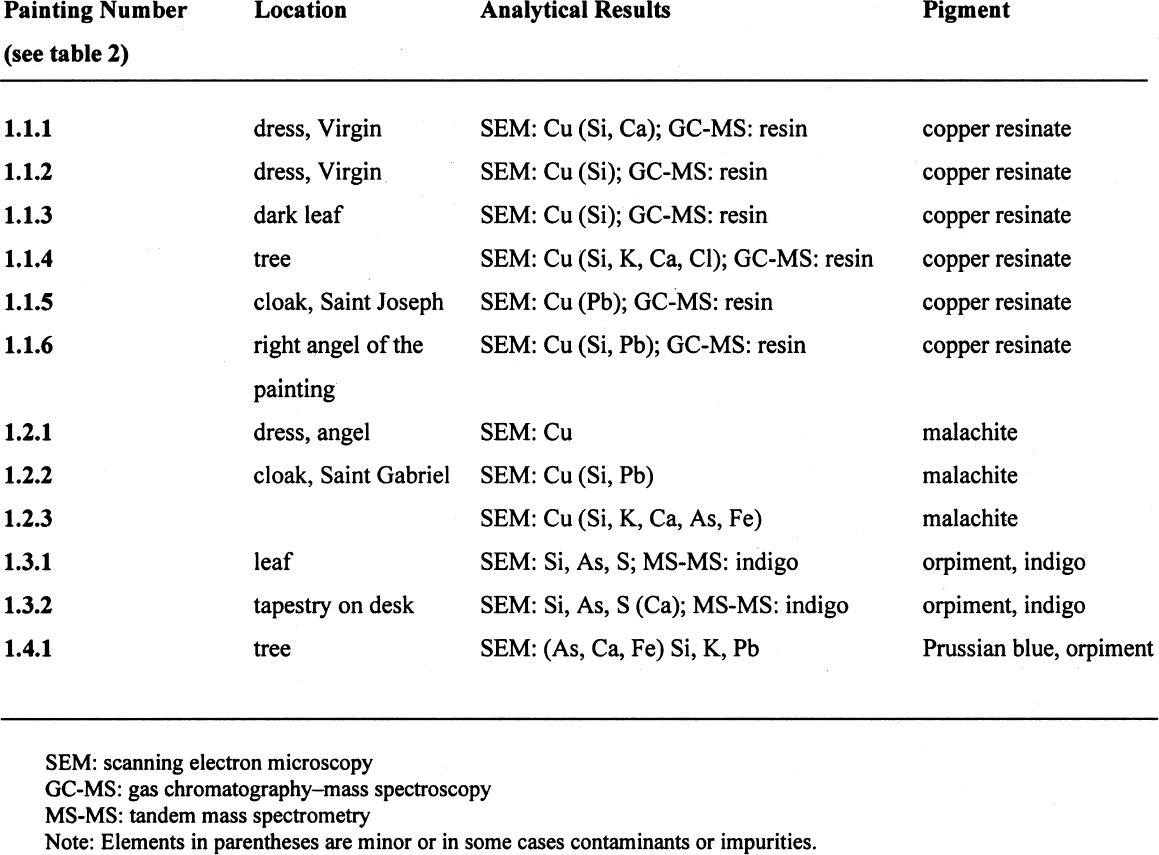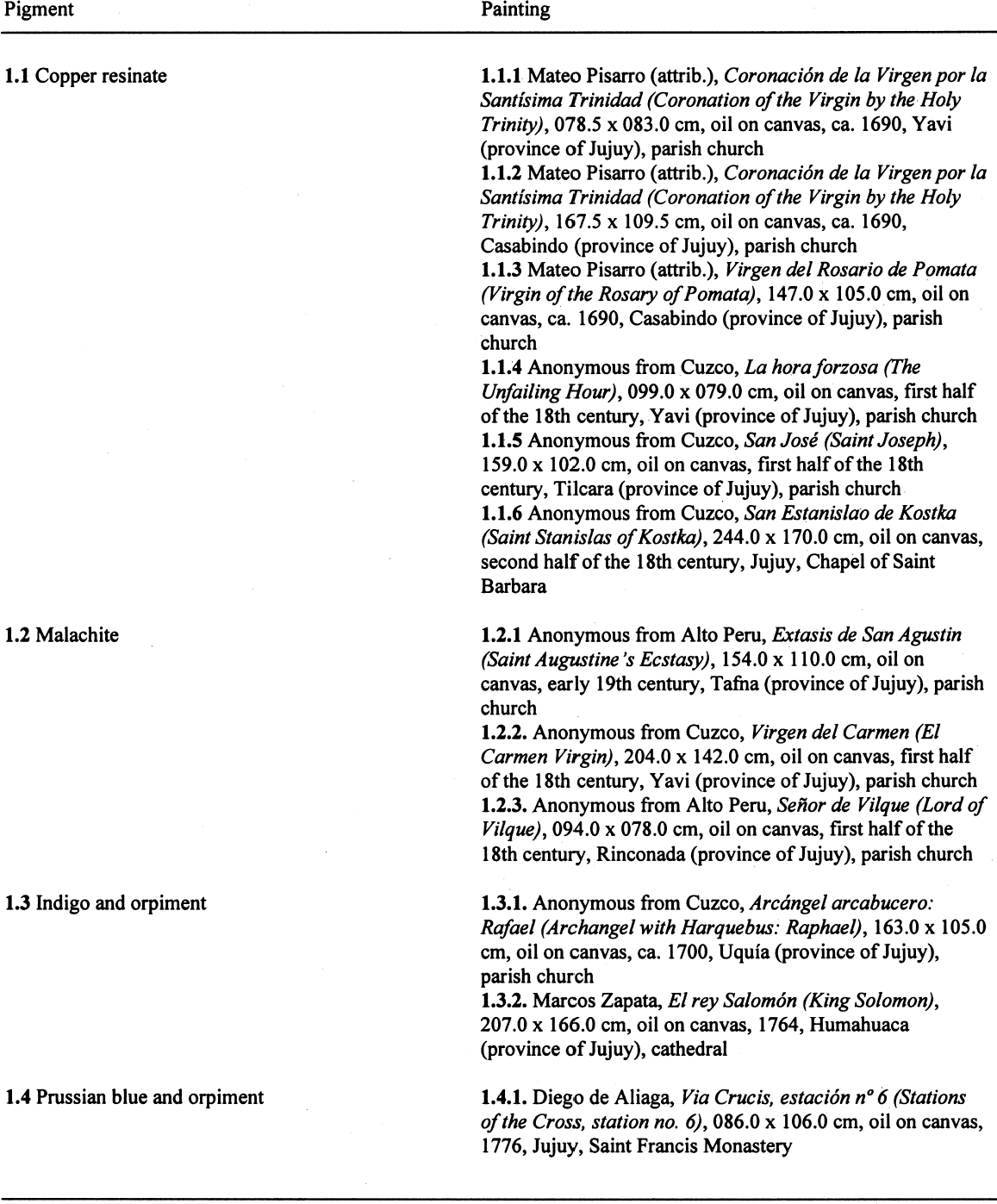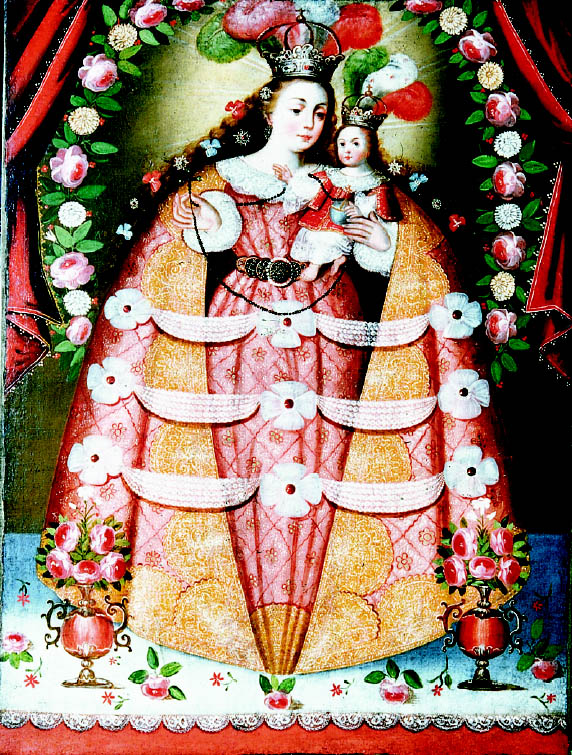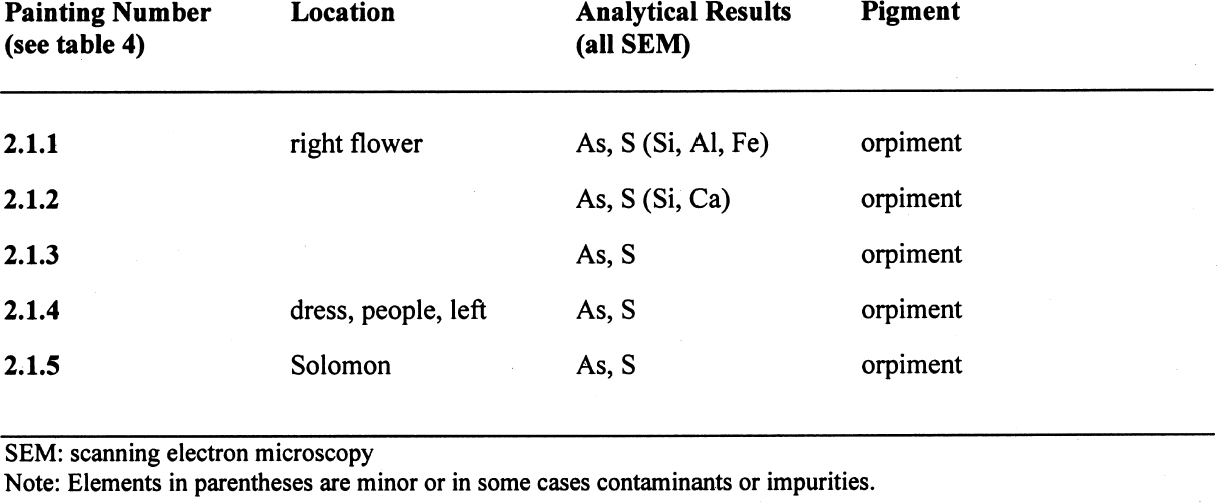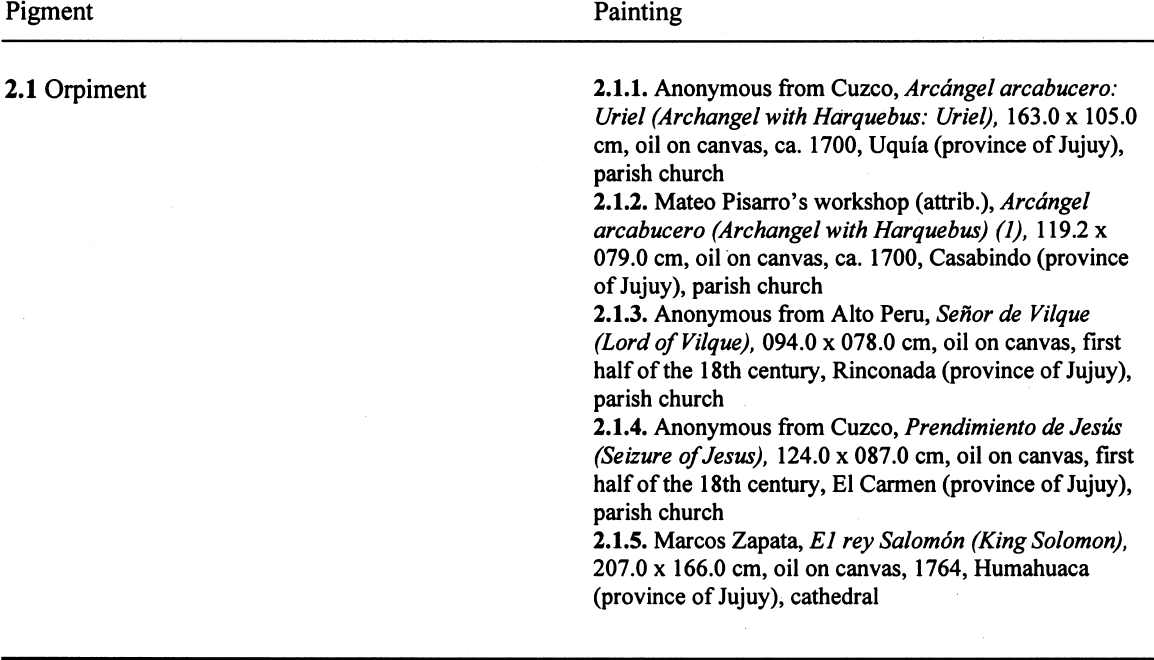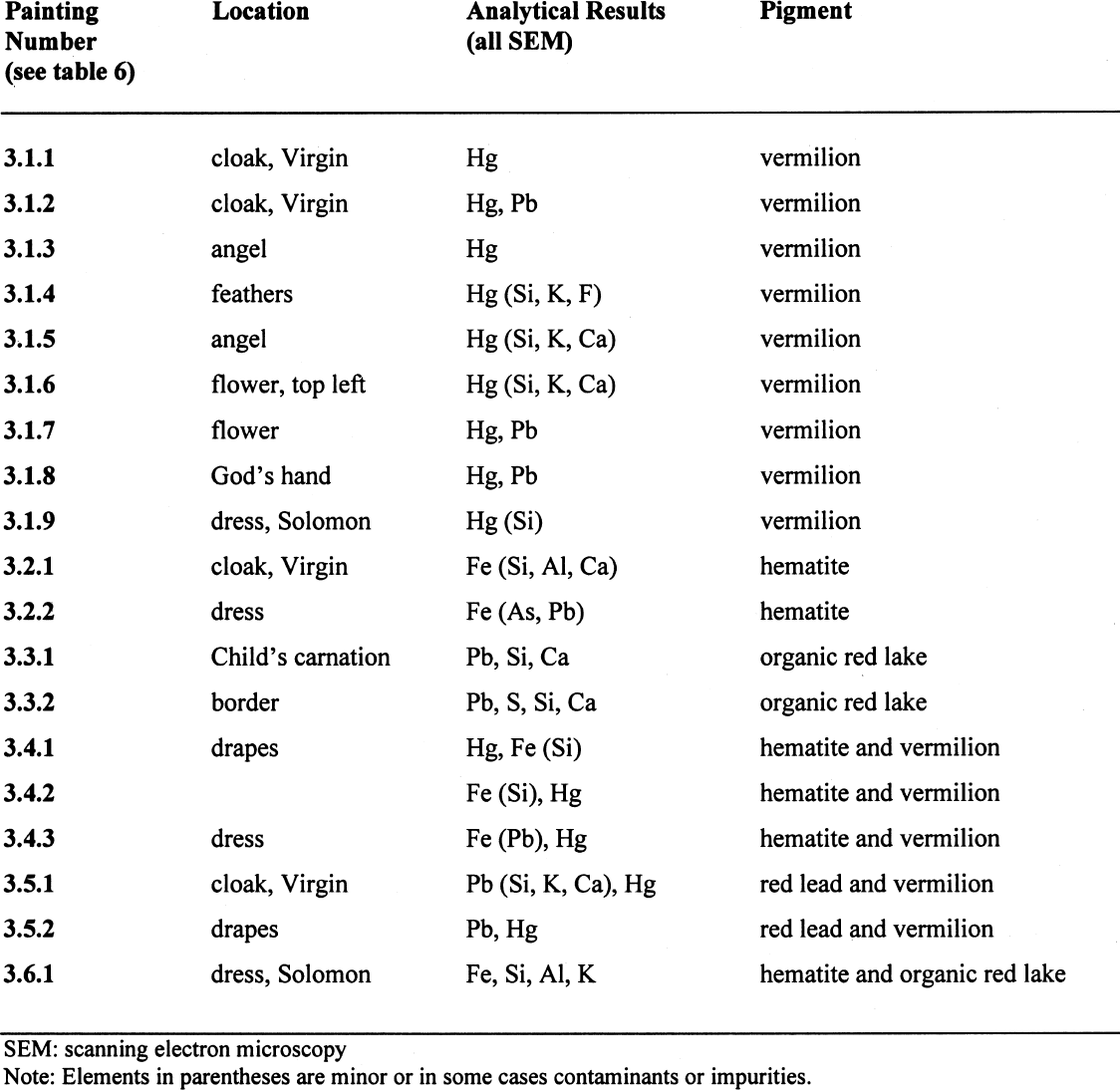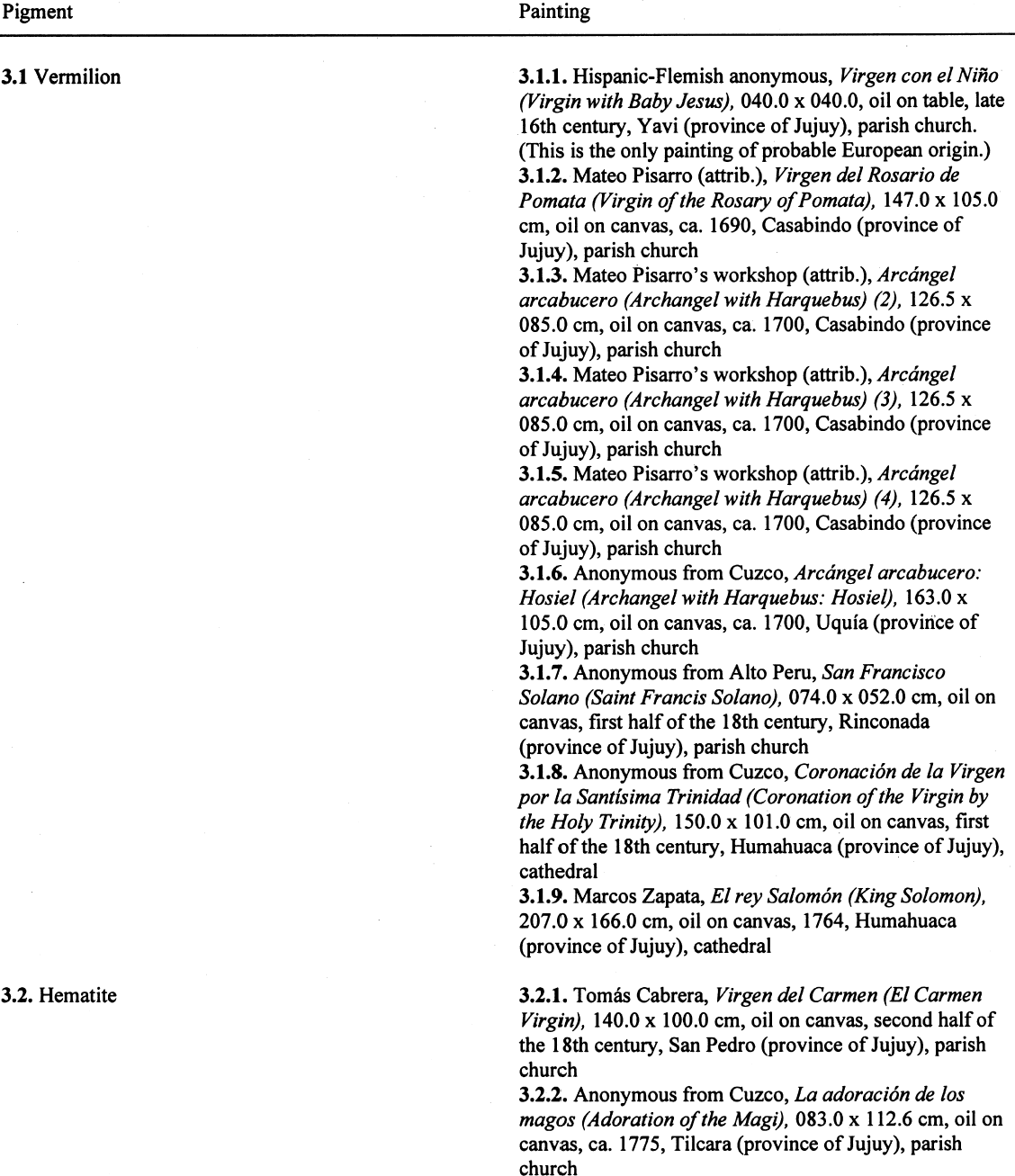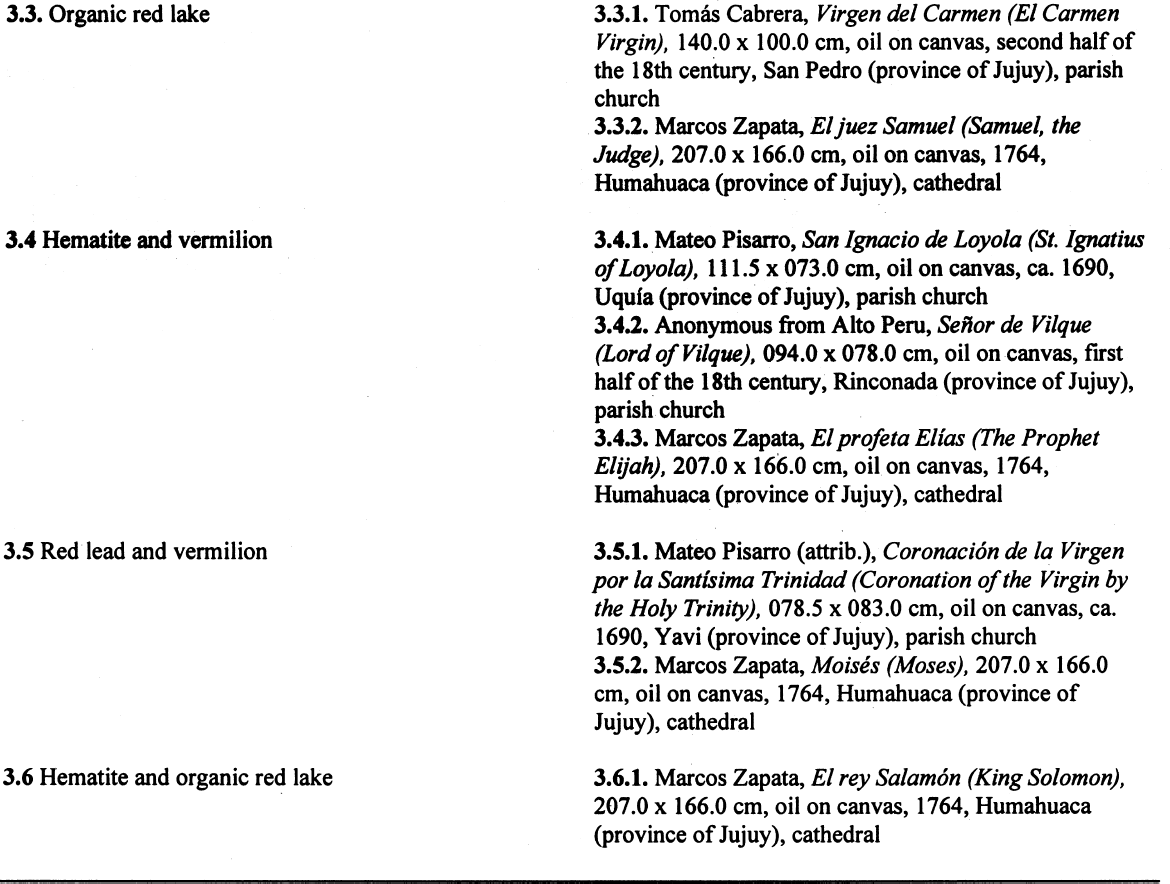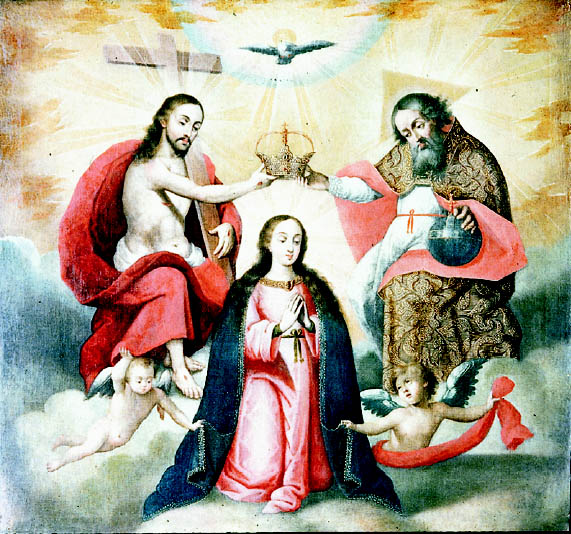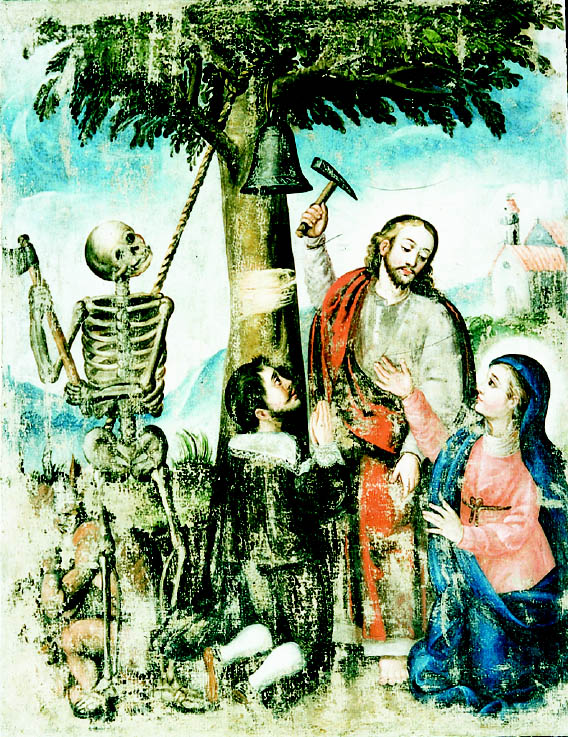GREEN, YELLOW, AND RED PIGMENTS IN SOUTH AMERICAN PAINTING, 1610–1780ALICIA SELDES, JOS� E. BURUC�A, GABRIELA SIRACUSANO, MARTA S. MAIER, & GONZALO E. ABAD
ABSTRACT—A multidisciplinary team of chemists and art historians from the University of Buenos Aires and the National Council of Scientific and Technological Research (CONICET) has examined the green, yellow, and red pigments used in a collection of 29 paintings from the highlands of Peru in the Andean region during the colonial period (1610–1780). The results described in this paper are a continuation of previous research on blue pigments found in the same corpus (JAIC 38 [1999]: 100–23). The results show how the artists from the big workshops of Cusco and the cities of the Alto Peru (the highlands of Bolivia and N.W. Argentina) followed the recipes for color preparation included in the technical treatises written by Spanish painters. Once again, the figure of Mateo Pisarro, an artist active in the Puna of Atacama at the end of the 17th century, emerges as an exceptional investigator of color-rendering problems. TITRE—Les pigments verts, jaunes et rouges dans la peinture sud-am�ricaine (1610–1780). R�SUM�— Une �quipe multidisciplinaire, form�e de chimistes et d'historiens de l'art de l'Universit� de Buenos Aires et du Conseil national de recherche scientifique et technologique (CONICET), a analys� les pigments verts, jaunes et rouges employ�s dans un ensemble de 29 peintures de la p�riode coloniale (1610–1780), et provenant du haut plateau de la Bolivie et du nordouest de l'Argentine (l'Altiplano) dans la r�gion des Andes. Les r�sultats d�crits dans cet article font suite � une recherche au pr�alable sur les pigments bleus, que l'on peut retrouver dans le m�me corpus (JAIC 38 [1999]: 100–23). Les r�sultats d�montrent de quelle mani�re les artistes, qui ont œuvr� dans les grands ateliers de Cuzco et des villes de l'Altiplano, ont suivi les recettes de pr�paration des couleurs que l'on retrouve dans les trait�s techniques �crits par les peintres espagnols. Une fois de plus, Mateo Pisarro, un artiste actif dans la puna de l'Atacama � la fin du XVIIe si�cle, fait figure exceptionnelle de par son investigation sur le probl�me du rendu des couleurs. TITULO—Pigmentos verdes, amarillos y rojos en la pintura suramericana de 1610 a 1780. RESUMEN—Un equipo multidisciplinario de qu�micos y de historiadores del arte de la Universidad de Buenos Aires y del Consejo Nacional de Investigaciones Cient�ficas y T�cnicas (CONICET) examin� los pigmentos verdes, amarillos y rojos utilizados en una colecci�n de 29 cuadros del Alto Per� que datan del periodo colonial (1610–1780). Los resultados descritos en este articulo son la continuaci�n de la investigaci�n hecha anteriormente sobre los pigmentos azules encontrados en las mismas obras (JAIC 38 [1999]: 100–23). Los resultados muestran c�mo los artistas de los grandes talleres de Cusco y de las ciudades del Alto Per� (las ciudades en la regi�n andina de Bolivia y el noroeste de la Argentina) siguieron las recetas para la preparaci�n de color encontradas en los tratados de pintores espa�oles. Una vez mas, la figura de Mateo Pisarro, un artista activo en la Puna de Atacama a finales del siglo XVII, se destaca como un investigador excepcional de los problemas que se presentan al querer lograr colores espec�ficos. 1 INTRODUCTIONThe aim of the present work is to extend the study of the colonial Andean palette following the same guidelines used in our earlier work on blue pigments (Seldes et al. 1999). In the first part we were able to correlate the historical data and the results of chemical analysis. The data refer to the uses of several blue pigments (indigo, azurite, smalt, Prussian blue, and their mixtures) mentioned by the Spanish theorists of the Baroque period (e.g., Vicente Carducho, Francsico Pacheco, Antonio Palomino de Castro y Velasco) and their application in South American colonial paintings of the 17th and 18th centuries. It was found that most workshops of Cusco and the cities of the highlands of Peru (whose production was an important part of the study) closely followed the recipes for obtaining blue hues quoted by the authors mentioned above. An outstanding example was identified This second part of our study focuses on 29 paintings selected from the corpus of 106 works that we studied in the first part. Those 29 works of art belong to the Cuscan and Alto-Peruvian schools of painting or were painted by Mateo Pisarro, with one exception—Virgin with Baby Jesus (painting 3.1.1) in an altar at the Yavi chapel—which probably came from Flanders to South America in the 17th century. The results describe the practices of colonial times used to obtain green, yellow, and red hues in painting. The main hypothesis was, once again, the remarkable performance of Mateo Pisarro when dealing with pigments other than blue: viz., green, yellow, and red tints. Pisarro's originality led us to examine a particular relationship between him and Melchor P�rez Holgu�n (second half of the 17th century), a great master of the Potosinian school who also obtained brilliant results in the field of color rendering. Market conditions in South American colonial cities were considered a main force in the process of artistic production, not only from masters of traditional workshops in Cusco but also from Mateo Pisarro himself. A brief description of the Cusco and Alto-Peruvian schools of painting in colonial times follows. According to the guidelines established by three Italian artists active in the viceroyalty of Peru at the beginning of the 17th century—Bernardo Bitti (1548–1610), Angelino Medoro (1547–ca. 1630), and Mateo P�rez de Alesio (ca. 1545–ca. 1616)—Cuscan painting followed the manner of the High Renaissance until 1650. In the second half of the 17th century, local painters such as Jos� Espinosa de los Monteros (second half of the 17th century), the Indian Basilio de Santa Cruz (active 1661–1700), and the mestizo Diego Quispe Titos (1611–1681?) in Cusco, and Mechor P�rez Holgu�n in Potos� (Bolivia) introduced and adapted to Andean society the Baroque style that they knew mainly from copies of Spanish canvases and engravings produced in the Flemish, French, or Italian workshops, all of them spread by trade throughout the entire Spanish American territory. During the 18th century large series of works were produced in an almost industrial fashion by artists such as Marcos Zapata (second half of the 18th century, active 1748–1764), Basilio Pacheco (middle of the 18th century), Diego de Aliaga (second half of the 18th century) in Cusco, or Gaspar de Berr�o (second half of the 18th century) in Potos�. All developed and standardized the characteristics of the Andean Baroque style: dynamic compositions, emphatic expressions in faces and gestures, light and shadow effects, and a rich palette. It is important to point out a non-European variable that could have influenced the artistic reception of Native viewers of Christian religious painting in colonial times: the symbology of colors in the Inca and other pre-Columbian civilizations of the Andean regions. In pre-Hispanic South America, the color red, as well as blue, green, and yellow, were symbolically associated with the Inca himself and the gods. For the Native population, the bright and glittering, well-defined colors in the clothes and headdresses of noblemen were a symbolic manifestation of holiness and an expression of social inequalities, domination, and political, economic, and military power. 2 METHODOLOGY2.1 TECHNICAL ANALYSIS OF PIGMENTSThe 29 works studied were part of a restoration and preservation project undertaken by the X-ray diffraction (XRD) was performed on a Phillips diffractometer (PW 1050), with copper radiation and nickel anticathode with different voltages for each spectra, depending on the sample. Tandem mass spectrometry (MS-MS) for the detection of indigo was performed on a ZAB hybrid spectrometer (Micromass, Manchester, UK) (BeqQ), filtering the molecular ion of indigo with B (magnetic sector), colliding with helium in the second, field-free region, and analyzing the fragments with E (electrostatic sector). Copper resinate appeared transparent and viscous green under the optical microscope, and it did not show evidence of particles. The small amount of sample available prevented exact identification of its components by gas chromatography–mass spectrometry, but oil or protein could be excluded and the presence of signals like terpenes similar to those of some conifers could be observed. The presence of copper was determined by SEM, in addition to microchemical tests using rubeanic acid (Plesters 1956). Feigl's procedure (Feigl 1958, 80–82) was also used to determine the presence of copper by catalyzing the iron thiosulfate reaction through the presence of copper ions. None of the aforementioned methods was useful for detecting the acetate group. Among the analytical criteria used for the identification of malachite are solubility and effervescence in cold 3N hydrochloric acid (HCl) and in concentrated nitric acid (HNO3) (Gettens and FitzHugh 1993), performed on the cross sections. A test for copper in malachite using rubeanic acid (Plesters 1956) was performed on the samples. When a solubility test in ammonia was performed, the solution turned deep blue, indicating a copper-ammonia complex. SEM elemental analysis indicated in all cases the presence of copper as a sole component or sometimes with minor impurities such as lead, silicon, calcium, aluminum, or iron. Orpiment was identified where SEM results indicated the presence of arsenic (As) and sulfur (S). Some microchemical tests were also performed. The pigment was soluble in 3N hydrochloric acid, giving off hydrogen sulfide, and in concentrated nitric acid, giving off arsenic. It was also soluble in sulfuric acid and in 4N sodium hydroxide (Plesters 1956). Vermilion was identified where SEM results indicated the presence of mercury (Hg). The pigment was not affected by dilute or concentrated nitric acid, hydrochloric acid, or sulfuric acid. It was also unaffected by 4N sodium hydroxide. Red earth pigments such as hematite were identified from the presence of iron (Fe), detected by SEM analysis. To identify carmine lake, a small sample was hydrolyzed and analyzed by thin-layer chromatography (TLC) on acetylcellulose according to the procedure described by Masschelein-Kleiner and later compared with results obtained for a genuine sample of carminic acid (Masschelein-Kleiner 1967; Masschelein-Kleiner and Heylen 1968). Red lead was indicated by the presence of lead in SEM analysis. Some microchemical analyses were also performed, such as insolubility in 4N sodium hydroxide and solubility in dilute acids. 2.2 PIGMENT REFERENCES IN ART-HISTORICAL LITERATUREAvailable references on the pigments (apart from blue) used in colonial South American art refer to cardenillo (verdigris), coravari (chrysocolla), and earths for green hues; g�nuli, jalde (orpiment), and saffron for yellow hues; grana de M�xico (cochineal from Mexico) or magna, achiote, vermilion, minium, dragon's blood, and red earths for red hues; and white lead for white hues and lights, as well as ochers, earths, and ivory black for shadings. Understanding pigment nomen-clature has been problematic. Undoubtedly due to Specific treatises and manuals, such as Carducho's ([1633]1979), Pacheco's ([1649]1990), Palomino's ([1723]1988), and Manuel Samaniego y Jaramillo's (Vargas 1975) offer a broader palette including a wide range of hues as well as recipes and recommendations for mixing and applying pigments. Pacheco mentions mountain green (a copper ore that results in a light green hue, which may be related to malachite), earth green, and verdacho (also used by Palomino)—all of them derived from mineral sources. Among other pigments used during this period, red lead (in Spanish, azarc�n) is also mentioned. It is a burnt lead oxide, orange-red in color, and also known as minium or Saturn red. This color was considered by Palomino ([1723]1988) among the “false colors” because the colors shifted and became duller as the paint dried (literally,“when drying it casts out crusts which strip away all gentleness from the painting” [135–36]). Another such pigment is the encorca, mentioned by Pacheco and Palomino as “Flanders' encorca,” which yields a dark yellow hue. There are documents on pigment traffic and how pigments were transported from one place to another. An anonymous manuscript of the 17th century, probably written by a converted Portuguese Jew, gives information on shipments of cochineal (carmine) from Mexico to Peru and also from Guatemala and Nicaragua. This “Memoir of All Kinds of Merchandises Necessary for Peru, Which Cannot Be Obtained Because They Are Not Made in This Country” records powdered cochineal from Valencia and verdigris (Lewin 1958, 121). Several private contracts and inventories were studied, such as the 1581 contract commissioning of Juan de Ponce to gild the retable of Church of Our Lady of Mercy in Cuzco. Other examples are the registrar book of the Church of Yucay in 1679 (Mesa and Gisbert 1982, 268–69); the accounting book of the Chapel of Our Lady of the Rosary in the monastery of Saint Dominic in Quito, dated 1823; and a list of tools and materials inventoried at the missions of Paraguay after the Jesuits were expelled from Spanish territory in 1767 (Ribera and Schenone 1948, 60). 3 RESULTS3.1 GREENSAnalyses of all green pigments indicated a copper ingredient (table 1). Electron microscopy showed crystals resembling malachite, mentioned in ancient treatises and in documents as mountain green. Chemical tests revealed the specific combinations and proportions that differentiate it from green earths. 3.1.1 Copper ResinateSix paintings were found to contain copper resinate, and these are listed in table 2. Copper resinate is a compound of cardenillo (verdigris) and a vegetable resin, similar to those obtained from some conifers or from copal trees, used as incense by Native Americans. It is composed mainly of copper salts of resinic acids. Spanish art literature refers to this resin as grassa or grasilla, also called sandarac by the Arabs. It was commercialized in Europe in liquid form, as a powder (dissolved in linseed oil to make a varnish similar to the liquid vernice of the Italians), and also in grain form (vernice in grana). It is worth mentioning that Spaniards used the green cardenillo varnish for coating or making velature on a dried base of a�il (indigo) and white, whereas it was found in some of the paintings of this collection applied directly on the primer layer, a procedure that produces an intense green. Mateo Pisarro used these recipes in his works, experimenting to obtain different hues, as exemplified by his ingenious use of copper resinate as a velatura upon an azurite blue for
Virgin of the Rosary of Pomata, at Casabindo (painting 1.1.3 [fig. 1]), is an interesting case because the above-mentioned resin may be found mixed with a pigment whose dissolved crystals are similar in appearance to malachite rather than to cardenillo. This fact is rather striking, since it contradicts recipes from classical manuals. Although we cannot confirm the presence of malachite, it is noteworthy to find such an unorthodox procedure in the techniques of a master like Pisarro, who ventured daring and subtle technical experimentation to achieve different hues.
Cardenillo, or verdigris, is basic copper acetate, the greenish or bluish corrosion that gathers on objects made of this metal. Palomino defines it as the “beautiful green of copper rust, under the vapors of vinegar” or lemon juice ([1723] 1988, 558). Although it is extremely poisonous, it was highly appreciated for its drying qualities in oil painting. However, Pacheco advised against its use in the following terms: “I do not use cardenillo, except with thin and cheerful blue ashes.” He obtained light and dark green hues by mixing this blue pigment with g�nuli and encorca ([1649] 1990, 484). Cardenillo is also mentioned in the
In extended areas painted with copper resinate, the original green color appeared as a faded brown layer. Such a surface-degradation phenomenon was clearly noticeable in stratigraphic cross sections, and the underlying layer had the original green color. Moreover, this alteration of the original color was absent in areas not exposed to light, i.e., in areas protected by frames or bordering tapes. It is possible that this discoloration might result from a photocatalytic reaction, specifically that such change in color may involve the photo-oxidation of the organic components of the pigment accompanied by the probable reduction of copper species to copper (I). At present, however, there is no experimental evidence to support this suggestion (Goetghebeur and Kockaert 1980–81). 3.1.2 MALACHITEThe three paintings that were found to contain malachite are listed in table 2. The malachite-based pigment, a basic copper carbonate extracted from the semiprecious stone of the same name, certainly came from the copper mines of Cerro Sapo, Bolivia (near Cochabamba), and Cazpana, Chile (province of Antofagasta), where azurite was also extracted (Seldes et al. 1999). Spanish manuals record it as mountain green or granillo, “which contributes to green hues” (Pacheco [1649]1990, 454). It was also known as green verditer, verde azzurro, Armenian stone (Montagna 1993; Roy 1993; Calvo 1997), chrysocolla, or chrysolite, according to Cobo: “A green stone that the Indians from the province of Lipes bring from their ancient mines to Potos� for sale, and is called coravari by the Indians of Peru … is none other, it seems, than the gem Dioscorides named chrysolite. Besides being useful for painters for its lovely green hues, it is of avail for many other purposes” (1890, 272). Malachite, a close relative of azurite, resulted sometimes in a greenish blue hue. Some sources refer to a blue-green color, a mixed color derived from the frequent combination of azurite and malachite in the same vein (Palomino [1723]1988, 557; Cobo 1890, 289). It seems that this color had been used from pre-Hispanic times and had—according to Father Alvaro Alonso Barba, priest at Saint Bernard's parish at the Imperial Villa of Potos�—optimum qualities for painting as well as healing powers. When referring to the colors of mineral ore extracted in the Andean area, Barba precisely described this hue as a “greenish blue” and explained that it is derived from the “Armenian stone or cibairo of the same color, and therefore painters call the color resulting from it blue-green” (Barba [1640]1967, 59). He later noted purging melancholy as among its powers. 3.1.3 Indigo and OrpimentA mixed green of indigo and orpiment was found on two paintings, which are listed in table 2. 3.1.4 Prussian Blue and OrpimentA mixed green of Prussian blue and orpiment was found on one painting, described in table 2. 3.2 YELLOWSThe results of the analyses of yellow pigments are shown in table 3. All five paintings that had yellow hues were found to contain orpiment. These paintings are listed in table 4. 3.2.1 ORPIMENTWarnings from scholars against the use of orpiment led to this pigment's gradual disappearance from the European palette, so its occurrence in our corpus is noteworthy. Also known in Spanish as jalde, orpiment
3.3 REDSBoth red and blue pigments have a prominent place within the color spectrum because of their economic and social meaning. In 15th-century Tuscany, carmine was the most expensive and highly prized pigment, even more than ultramarine. In symbology, it had the same status as purple, an expensive and highly coveted color from classical times onward, insofar as its presence in cloths suggested the dignity of kings and cardinals. The results of the analyses of red pigments are shown in table 5, and the paintings bearing red pigments are listed in table 6. 3.3.1 VermilionVermilion, also called cinnabar, is a natural mercury sulfide (HgS) extracted from quicksilver mines in Almad�n, Spain, and Idrija, Slovenia. In America, it was almost certainly extracted from Huancavelica mines (Peru, near Ayacucho), which were already exhausted in the 18th century. Cobo says that “the Indians from Peru use the name of Llimpi for quicksilver, the same metal from which they get vermilion” (1890, 322) for their paintings. Thus, the Jesuit priest Jos� de Acosta emphasized the use of this pigment called Llimpi by the Incas and natives from Peru: “it is highly prized for the same purpose Pliny has reported, … that of painting or dyeing their own faces and bodies as well as those of their idols, a very frequent practice in the past, especially in wartime, and also nowadays for feast days and dancing, which they call embijarse, because in old times they thought that thus painted their faces inspired awe, and now they feel they are decked in their best” (Acosta 1940, 251–52). Barba remarks that, before the conquest, the Indians from Potos� were not great consumers of quicksilver because the only use they made of it was to obtain cinnabar or vermilion for ritual purposes ([1640] 1967, 55). Such intense red color might be associated, then, with domination and war practices: it is also known that red was essential in the war attire of the Andean region (Molina and Albornoz 1988, 103) and was involved in rituals that were probably representations of war (as in the case of t'inku) and various sacred ceremonies. The Spanish word embijarse suggests a linguistic shift from bixa, the American name of a vegetable dye that was later adopted in botany to designate Bixa orellana or achiote (Arona 1883). Artificial vermilion was also known at the time, a vivid red color resulting from the roasted mixture of mercury and sulfur. The aforementioned documents of 1581, 1679, and 1823 explicitly cite vermilion in their list of colors. In the set of paintings under study, the fine grinding in works from Pisarro's workshop should be noted and contrasted with a coarser one in Marcos Zapata's paintings. Of the paintings in which vermillion was found, four are attributed to Mateo Pisarro or his workshop, two are from Cuzco, one is from Alto Peru, one is by Marcos Zapata, and one is probably of European origin (see table 6). 3.3.2 HematiteEarths were widely used as pigments in the Andean region. Most of them are light and dark
Hematite was found in a painting from Tom�s Cabrera and in one canvas from Cuzco, both from the 18th century (see table 6). 3.3.3 Organic Red LakeCarmine is an organic pigment, a red lake
As for South America, there are reports of wild cochineal in Loja, Ecuador; Carora, Venezuela; Tucum�n, Argentina; Peru; and Brazil, though most sources show, as in the case of a�il, a wide proliferation of the species together with a scant production and consumption. For cochineal “growing” to result in a bountiful “harvest,” a series of precautions and specific steps, which were entrusted to the Indians, were required. The whole process might be described as follows: First, nopal trees were planted, and after two or three years' growth, they were “seeded”—in other words, female cochineal insects ready for reproduction were scattered on the trees. The females were transported inside nests built with various materials and tied up to nopal stalks. Once the brood was born, they clung to the nopal tree, getting nourishment from its juices. When the new generation abandoned the nests, females were collected with soft brushes: it is from their dried bodies that the dye is obtained. When the final stage of the cycle was reached, the remaining cochineal were removed and killed using various methods—toasting, boiling, or steaming—and dried, in order to extract carminic acid, the desired dye of intense red color. The pigment itself was sent to market in loaves, in which form, to our knowledge, it reached the workshops of the artists. It was also used to immerse and ornament patterned clothes of lesser quality or cheaper price. The 1679 document cited above mentions the use of vermilion and magna. Organic red lake was found in two paintings, one by Tom�s Cabrera and the other by Marcos Zapata (see table 6). 3.3.4 Hematite and VermilionHematite appears in South American colonial sources related to vermillion in descriptions of ritual indigenous practices (Cobo 1890, 246). Paintings found to contain the mixed red of hematite and vermilion are listed in table 6. 3.3.5 Red Lead and VermilionTo obtain an orange-red color, painters used red lead, also known as minium or Saturn red, a burnt lead oxide (Pb3O4). This pigment was difficult to obtain, since it involved heating white lead under an air stream—the greater the oxidation, the darker the color—until it eventually turned bright orange. Mixed with linseed oil, red lead was used as a drier for carmine and vermilion. As mentioned above, Palomino classified red lead among “false” colors because of its tendency to shift to duller hues as the paint dried. However, this dulling could be prevented by purification with a vinegar washing. Pablo de C�spedes, according to a quotation found in Pacheco's work, ranked it among the “florid” and very expensive tempera paints and called it vermilion, a clear indication of the terminological confusion of the times with respect to these colors and many others ([1649] 1990, 445). In the Art of Metals, Barba himself considers red lead and vermilion the same mineral ([1640] 1967, 59). There are references to this pigment in the 1581, 1679, 1767, and 1823 contracts mentioned above. The mixture of red lead and vermilion was found in a painting from Mateo Pisarro and in another from Marcos Zapata (see table 6). 3.3.6 Hematite and Organic Red LakePaintings containing mixed reds of hematite and red lake are listed in table 6. 4 THE ART OF MIXINGAndean artists mixed their pigments with white to obtain halftones and used the pure pigment, dark earths, or some other pigment of the same color and different degree of saturation to reinforce dark strokes. White lead or ceruse, a basic lead carbonate (PbCO3Pb(OH)2), was used for whites. It was extracted from Az�ngaro mines and was widely used Samples obtained from Zapata's paintings exclusively show greens obtained by mixing indigo and orpiment, the resultant mixture sometimes applied onto a red earth. Considering the unsystematic sampling, the possibility of Zapata's using pure greens for some areas cannot be ignored, although it seems unlikely because of the relative scarcity of green in his palette, limited as it is to three colors (blue, red, and yellow or ocher) in the current series. Once again, the case of Mateo Pisarro is quite different because he created a wide variety of greens, either by applying his so-called velature “smalt” on green backgrounds—as in the case of warrior angels at Casabindo (paintings 3.1.3 [fig. 2] and 3.1.4) or by using copper resinate, as in one of the Virgin of the Rosary of Pomata (painting 1.1.3 [see fig. 1]) from Casabindo's Parish Church, in the Coronation of the Virgin by the Holy Trinity (painting 1.1.1 [fig. 3], and in The Unfailing Hour (painting 1.1.4 [fig. 4]), both in Yavi.
5 HISTORICAL CONCLUSIONS: COLOR, PATRONAGE, AND MARKETWhen trying to understand how painters from different schools and regions used available pigments, we are puzzled at first glance by the variety of the results obtained. Such differences stem not only from the skills, knowledge, and experience of each artist, but also from the economic value of the works involved, which was preestablished by contract, and the social conditions in which they were created. There is, on the one hand, the variegated palette and subtlety in color use of Pisarro's workshop in the Andean plateau, which constructs volumes, details textures, and manages to obtain flushes in carnations through the use of soft, thin brushes. On the other hand, there is Marcos Zapata's work, showing a limited palette and resorting to thick brush strokes
Even though Zapata was a highly renowned master and was commissioned for fine works, as was the case of the series for the cathedral entitled Litanies of the Virgin, his hastily and carelessly made canvases are characteristic of the large-scale production at the workshops of Cuzco during the 18th century. The lack of local workshops, added to the prestige of Cuzcan painting, brought about a steadily increasing artistic traffic toward the south of the viceroyalty, to satisfy the great demand for religious images required to evangelize new settlements and towns. There was an urgent need to speed production and reduce costs, which limited the colors in the palette, restricted the number of superimposed layers of paint, and resulted in rather coarse and unrefined color mixing. The dedication of Pisarro to achieving a particular shade in the rompimiento de gloria (literally, “the break of glory”) behind sacred figures, the smooth gradation of his haloes, his pentimenti on the Marian symbols in several of his paintings, and his unexpected skill in drawing grisailles in the monstrance of the Immaculate Conception of Yavi and in the book
The authors wish to draw attention to the unusual circumstances of a painter, Mateo Pisarro, living in the periphery of the American colonial empire, who felt such an urge to solve the aesthetic problems posed by the appropriation and re-creation of European models that reached him in black and white through engravings. It is not unlikely that he might have been spurred by the demands of the man who commissioned his works, his employer, Juan Jos� Campero. It should be noticed that we do not have any specific example of iconographic derivation from European engravings to Pisarro's paintings, but we do know that this method was the most widespread and universally accepted among Spanish American colonial artists. Finally, the authors wish to emphasize the relevance of interdisciplinary efforts such as the present one, since using a methodology derived from cultural history, based on heterogeneous sources such as images, chemical tests, and written documents, chemistry, and history of art together bring us closer to discovering the working methods and practices of South American artists of the colonial period. NOTES1. The term “sandarac” is used with different meanings in the language of art materials. As a pigment, REFERENCESde Acosta, Padre Jos�.1940. Historia natural y moral de las Indias. Mexico City: FCE. de Arona, J.1883. Diccionario de Peruanismos: Ensayo filol�gico. Lima, Peru: Imp. Francisco Sol�s. Barba, A. [1640] 1967. El arte de los metales. Los escritos de la Colonia N� 3. Potos�, Bolivia: Colec-ci�n Primera. Becco, H., ed.1992. Historia real y fant�stica del Nuevo Mundo. Caracas, Venezuela: Biblioteca Ayacucho. Buruc�a, J. E., et al.2000. TAREA de diez a�os, A. J�uregui and G. Siracusano. Buenos Aires: Ediciones Fundaci�n Antorchas. Calvo, A.1997. Conservaci�n y restauraci�n: Materiales, t�cnicas y procedimientos, de la A a la Z. Barcelona, Spain: Serbal. Carducho, V. [1633] 1979. Di�logos de la pintura. Madrid: Editorial Turner. Cobo, B.1890. Historia del Nuevo Mundo, vol. 1. Seville, Spain: Sociedad de Bibli�filos Andaluces. Cornejo Bouroncle, J.1960. Derroteros del arte cuzque�o: Datos para una historia del arte en el Per�. Cuzco, Bolivia. Dahlgren, B.1990. La grana cochinilla. Mexico City: UNAM. Feigl, F.1958. Spot tests in inorganic analysis. Amsterdam: Elsevier. Gettens, R. J., and E. W.FitzHugh. 1993. Malachite and blue verditer. In Artists' pigments: A handbook of their history and characteristics, vol. 2, ed. A.Roy. Washington, D.C.: National Gallery of Art and Oxford University Press. 183–200. Goetghebeur, N., and L.Kockaert. 1980–81. Le Grand Calvaire d'Albert Bouts au Mus�e des Beaux-Arts, Bruxelles. Bulletin de l'Institut Royal du Patrimoine Artistique18. Inventario de 1718 de los bienes del Marqu�s del valle de Tojo. 1991. In Patrimonio art�stico nacional: Provincia de Jujuy. Buenos Aires: Academia Nacional de Bellas Artes. Lewin, B., ed.1958. Descripci�n General del Reino del Per�, en particular de Lima. Colecci�n textos y documentos. Rosario, Argentina: Universidad Nacional del Litoral, Instituto de Investigaciones Hist�ricas. Masschelein-Kleiner, L.1967. Microanalysis of hydroxyquinones in red lakes. Mikrochimica Acta6:1080–85. Masschelein-Kleiner, L., and J. B.Heylen. 1968. Analyse des laques rouges anciennes. Studies in Conservation13:87–97. de Mesa, J., and T.Gisbert. 1982. Historia de la pintura Cuzque�a. Lima, Peru: Banco Wiese. de Molina, C., and C.de Albornoz. 1988. Relaci�n de las f�bulas y ritos de los Incas. In F�bulas y mitos de los Incas, ed. H.Urbano and P.Duviols. Madrid: Historia. 16. Montagna, G.1993. I pigmenti: Prontuario per l'arte e il restauro. Florence, Italy: Nardini. Motolinia, Fray Toribio de. 1985. Memoriales o libro de las cosas de la Nueva Espa�a (selected fragments). In Historia de la ciencia en M�xico: Estudios y textos, siglo XVI, vol. 1, ed. E.Trabulse. Mexico City: FCE. Pacheco, F. [1649] 1990. Arte de la pintura. Madrid: C�tedra. Palomino de Castro y Velasco, A. [1723] 1988. El Museo Pict�rico y Escala �ptica. Vol. 2, Pr�ctica de la pintura. Madrid: Aguilar. Plesters, J.1956. Cross sections and chemical analysis of paint samples. Studies in Conservation2:110–57.
Ribera, A. L., and H.Schenone. 1948. El arte de la imaginer�a en el R�o de la Plata. Buenos Aires: Instituto de Arte Americano e Investigaciones Est�ticas. Roy, A., ed.1993. Artists' Pigments: A Handbook of Their History and Characteristics, vol. 2. Washington, D.C.: National Gallery of Art. Seldes, A., and J. E.Buruc�a. 1998. Una serie de pinturas cuzque�as de Santa Catalina: Historia, restauraci�n y qu�mica. Buenos Aires: Fundaci�n TAREA. Seldes, A. M., J. E.Buruc�a, M. S.Maier, G.Abad, A.J�uregui, and G.Sirascusano. 1999. Blue pigments in South American painting (1610–1780). Journal of the American Institute for Conservation38:100–23. Vargas, J. M.1975. Manuel de Samaniego y su tratado de pintura. Quito, Ecuador: Ed. Santo Domingo. FURTHER READINGQuerejazu Leyton, P.1986. Materials and techniques of Andean painting. In AAVV, Gloria in excelsis: The Virgin and angels in vicerregal painting of Peru and Bolivia. New York: Center for Inter-American Relations. AUTHOR INFORMATIONALICIA M. SELDES is professor in the Department of Organic Chemistry in the Faculty of Exact and Natural Sciences of the University of Buenos Aires, senior researcher of the National Council of Scientific and Technological Research (CONICET), and adviser in chemistry at the Fundaci�n TAREA. Her areas of research interest are the analysis of traces of organic compounds and their structure through mass spectrometry techniques and the study of biologically active natural products of both marine and terrestrial origins. Since 1988, her link to the Fundaci�n TAREA has extended her research to organic and inorganic materials used in colonial easel painting. Address: Department of Organic Chemistry, Faculty of Exact and Natural Sciences, University of Buenos Aires, Pabell�n 2, Ciudad Universitaria, (1428) Buenos Aires, Argentina. JOS� EMILIO BURUC�A studied history of art and history of science with Hector Schenone, Carlo del Bravo, and Paolo Rossi. He obtained his doctorate at the University of Buenos Aires, where he is now professor and chair of modern history. He has been the director of research at the National Museum of Fine Arts, Buenos Aires, and vice-dean at the School of Philosophy and Letters, University of Buenos Aires. A member of the National Academy of Fine Arts and adviser in the history of art at Fundaci�n TAREA, he has published books and articles on the history of perspective and on the historical relations between images and ideas. Address: Julio E. Payr� Theory and Art History Institute, University of Buenos Aires, 25 de Mayo 217, (1002) Buenos Aires, Argentina. GABRIELA SIRACUSANO is assistant professor of research methodology and of the historiography of art at the School of Philosophy and Letters, University of Buenos Aires, and assistant researcher of the National Council of Scientific and Technological Research (CONICET). She is also a staff researcher at the Julio E. Payr� Theory and Art History Institute, University of Buenos Aires, and president of Argentine Center of Art History Researchers (CAIA). She has carried out and published studies on the relations between art and science. Address as for Buruc�a. MARTA S. MAIER is assistant professor in the Department of Organic Chemistry, Faculty of Exact and Natural Sciences, University of Buenos Aires, and assistant researcher of the National Council of Scientific and Technological Research (CONICET). Her areas of interest include biologically active compounds in echinoderms and the synthesis of their analogues. Since 1992 she has extended her scope to research on the organic materials found in colonial easel painting. Address as for Seldes. GONZALO E. ABAD is a student of pharmacy at the University of Buenos Aires. He collaborates with the project of materials used in colonial easel painting. Address as for Seldes.
 Section Index Section Index |
